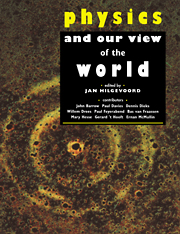Book contents
- Frontmatter
- Contents
- Foreword
- Introduction
- 1 Questioning the answers or Stumbling upon good and bad Theories of Everything
- 2 Theories of Everything
- 3 The scientific view of the world: introduction
- 4 Enlarging the known world
- 5 The world of empiricism
- 6 Has the scientific view of the world a special status compared with other views?
- 7 Quantum theory and our view of the world
- 8 Interpretation of science; science as interpretation
- 9 Problems in debates about physics and religion
- 10 The mind of God
- 11 The sources of models for God: metaphysics or metaphor?
- Discussion
- Notes on contributors
- Bibliography
- Index
3 - The scientific view of the world: introduction
Published online by Cambridge University Press: 04 December 2009
- Frontmatter
- Contents
- Foreword
- Introduction
- 1 Questioning the answers or Stumbling upon good and bad Theories of Everything
- 2 Theories of Everything
- 3 The scientific view of the world: introduction
- 4 Enlarging the known world
- 5 The world of empiricism
- 6 Has the scientific view of the world a special status compared with other views?
- 7 Quantum theory and our view of the world
- 8 Interpretation of science; science as interpretation
- 9 Problems in debates about physics and religion
- 10 The mind of God
- 11 The sources of models for God: metaphysics or metaphor?
- Discussion
- Notes on contributors
- Bibliography
- Index
Summary
It is my aim to introduce the themes brought up by Paul Feyerabend, Ernan McMullin and Bas van Fraassen by means of a brief overview — partly historical and partly systematical — of the realist and empiricist positions with respect to science. My selection and presentation of topics has been influenced by the wish to make a connection with some of the points raised in other contributions to this volume, especially the earlier chapters. (What do the results of modern physics tell us about reality?)
The traditional view of science
In the traditional Aristotelian view, science is the unique enterprise in which humanity discovers fundamental truths about the world in a systematic, rational, way. According to this view the result of scientific investigation is knowledge, to be contrasted with mere opinion; knowledge is defined as provably true, fundamental and universal. There are a number of characteristic ingredients in this conception.
Realism
Inherent in the traditional view is the realist position that science deals with an independent external world, which for its greater part is not accessible to the human senses but can nevertheless be discovered, investigated and described. Science actually focuses on these unobservable traits of the world, in order to give fundamental explanations.
Information
- Type
- Chapter
- Information
- Physics and our View of the World , pp. 61 - 78Publisher: Cambridge University PressPrint publication year: 1994
